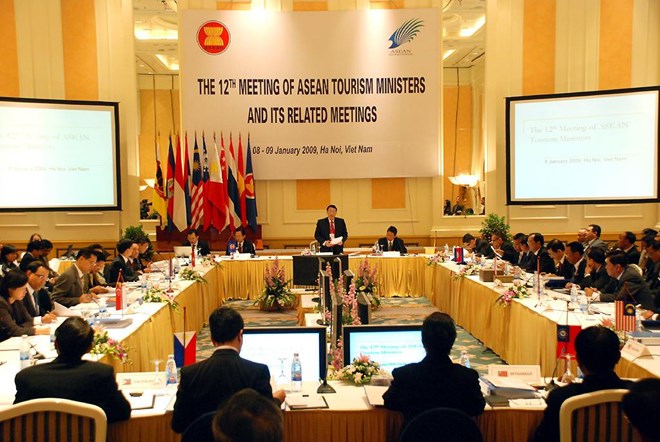AEC brings opportunities, challenges for Vietnam’s tourism
The ASEAN Economic Community (AEC) officially came into being on December 31, opening up opportunities for more intensive cooperation in various areas among member countries.
The AEC will allow the free flow of labour among ASEAN countries in eight sectors, including tourism, which affords both opportunities and challenges to employment.
As part of efforts to accelerate the formation of the AEC, ASEAN member countries paid attention to the liberalisation of three major areas, which were trade, investment and labour.
They have signed eight mutual recognition agreements to facilitate the movement of skilled labourers, thus promoting investment and trade activities.
Those included the Mutual Recognition Agreement on Tourism Professionals (MRA-TP), which enables skilled tourism workforce from other ASEAN nations to work in Vietnam and vice versa.

The meeting of ASEAN tourism ministers in Hanoi. (Photo: VNAT)
A report released by the Institute for Tourism Development Research (ITDR) shows that with an average growth rate of 6.2 percent during 2011-2015, Vietnam’s tourism sector will need an estimated 620,000 workers (tour guides, receptionists and others) by the end of 2015. The figure is expected to climb to 870,000 in 2020.
Experts said the tourism industry’s personnel demand is two to three times higher than that of other key sectors such as education, health care and finance.
Around 1.8 million labourers are working in Vietnam’s tourism sector. Although the industry needs an additional 40,000 workers every year, training establishments graduate only around 15,000 annually, with just 12 percent obtaining higher education degrees. Many tour guides have failed to meet requirements for skills and foreign languages.
Dr. Ha Van Sieu, deputy head of the Vietnam National Administration of Tourism (VNAT), warned that those who do not try to improve themselves to meet regional standards may lose their jobs right in the domestic market.
At a press conference on the implementation of the MRA-TP on November 25, Tran Phu Cuong, deputy head of the VNAT’s International Cooperation Department, said Vietnamese workers are hard-working and smart but they show weaknesses in foreign languages, soft skills and creativity.
Therefore, he said, training and self-study play a significant role. Tourism schools are gearing towards the EU-funded Vietnam Tourism Occupancy Standard (VTOS), as well as other occupational standards set by the Ministry of Culture, Sport and Tourism and the General Directorate of Vocational Training, Cuong said.
Head of the International Cooperation Department under the VNAT Dinh Ngoc Duc said labour export and import should be seen as exchange activities to bring the best-quality services and improve competitiveness for domestic tourism.
He noted that domestic training establishments have designed new curricular while tourism businesses, accommodation facilities and hotels have actively provided training in occupational skills to their staff in accordance with ASEAN’s trends.
Six professions in tourism will be recognised in the bloc when the AEC is formed at the end of this year, namely room services, reception, restaurant, cooking, travel agent and tour operation.
Deputy Director General of the VNAT Ha Van Sieu said Vietnam has strength in room services and reception, citing 60 percent of Vietnamese tourist workers work at hotel and restaurants.
To help businesses and workers become confident in the integration playground, the tourism sector has prepared all necessary conditions to implement training programmes.
An EU-funded project has helped the industry build a set of 13 tourism occupational standards and a group of trainers to support tourist companies.
The sector also plans to enhance capacity for tourism professional schools, including 10 under the Ministry of Culture, Sports and Tourism, focusing on training programmes, teacher education, equipment, occupational assessment centers and practicing facilities, towards meeting regional and international standards.
Human resource development will be key to whether Vietnam’s tourism can benefit fully from regional integration.
VNA
 Community tourism transforms livelihoods in remote areas
Community tourism transforms livelihoods in remote areas
 Agoda lists Da Lat among cheapest destinations for year-end holidays
Agoda lists Da Lat among cheapest destinations for year-end holidays
 TasteAtlas picks out two Vietnamese dishes among world’s 100 best rated crustacean dishes
TasteAtlas picks out two Vietnamese dishes among world’s 100 best rated crustacean dishes
 Vietravel expands business in Indian market
Vietravel expands business in Indian market
 2025 Nha Trang – Khanh Hoa Sea Festival to spotlight cultural heritage space
2025 Nha Trang – Khanh Hoa Sea Festival to spotlight cultural heritage space
Vietnam, a unique destination attracting Indian tourists: Indian newspaper
 Cao Bang eyes new opportunities for cross-border tourism development
Cao Bang eyes new opportunities for cross-border tourism development
 Kien Giang strives to attract tourists to finish the year on high note
Kien Giang strives to attract tourists to finish the year on high note
 Rivers provide major resources to boost Vietnam’s tourism
Rivers provide major resources to boost Vietnam’s tourism
 Dong Thap plants over 100 ha of flowers for Tet
Dong Thap plants over 100 ha of flowers for Tet




